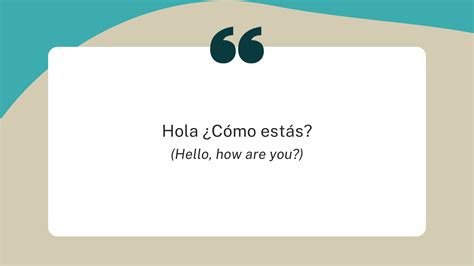How To Say Hi in Spanish: A Comprehensive Guide
Learning a new language can be exciting, and one of the first things you'll want to know is how to greet people. This guide dives deep into the various ways to say "hi" in Spanish, offering context and nuances to help you navigate different social situations with confidence.
Basic Greetings: The Everyday "Hi"
The most common way to say "hi" in Spanish is "Hola" (pronounced O-la). This is a versatile greeting suitable for almost any situation, from casual encounters to formal settings. It's the Spanish equivalent of "hello" or "hi," and you can use it with friends, family, colleagues, or strangers.
Beyond "Hola": Expanding Your Spanish Vocabulary
While "Hola" is your go-to greeting, understanding the context adds depth to your interactions. Consider these alternatives:
Informal Greetings:
- "Hey": While there isn't a direct translation for "Hey," "Oye" (pronounced O-yeh) is a close informal equivalent. Use it cautiously; it can sound slightly demanding if misused.
- "What's up?": Spanish doesn't have a direct equivalent, but you could use "¿Qué tal?" (pronounced Kay-tal) which translates to "What's up?" or "How's it going?". It's an informal way to greet someone and shows you care about their well-being.
- "How are you?": A more polite and formal way to greet someone is "¿Cómo estás?" (pronounced Ko-mo eh-stahs) if you're speaking to someone you know informally. For a more formal setting, use "¿Cómo está?" (pronounced Ko-mo eh-stah).
Formal Greetings:
- "Good morning": Use "Buenos días" (pronounced Bway-nos dee-as) from sunrise to noon.
- "Good afternoon": Use "Buenas tardes" (pronounced Bway-nas tar-des) from noon to sunset.
- "Good evening/Good night": Use "Buenas noches" (pronounced Bway-nas no-ches) from sunset to sunrise. This is also a polite way to say goodnight.
Using Greetings Effectively: Context is Key
The success of your greeting depends heavily on the context. Consider these factors:
- Your relationship with the person: Use informal greetings with friends and family, and formal greetings with strangers, colleagues, or elders.
- The time of day: Using "Buenos días," "Buenas tardes," or "Buenas noches" shows respect and cultural awareness.
- The setting: A casual setting calls for informal greetings, while a formal setting requires more formal options.
Mastering the Nuances: Beyond the Words
Learning how to say "hi" in Spanish is just the beginning. Practice pronunciation, observe native speakers, and don't be afraid to experiment. The more you immerse yourself in the language, the more confident and fluent you'll become. Remember, a warm smile and friendly demeanor go a long way in any language.
Boosting Your SEO: Keywords and Phrases
This article incorporates relevant keywords and phrases throughout, including "how to say hi in Spanish," "Spanish greetings," "Hola," "Buenos días," "Buenas tardes," "Buenas noches," "¿Qué tal?", "¿Cómo estás?", and "¿Cómo está?". This strategic keyword placement improves search engine optimization (SEO), increasing the article's visibility to those searching for information on Spanish greetings. Remember to also use these keywords naturally within your content to avoid keyword stuffing.
